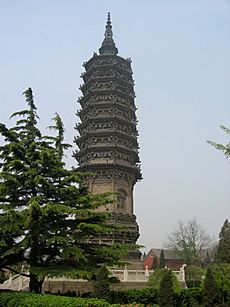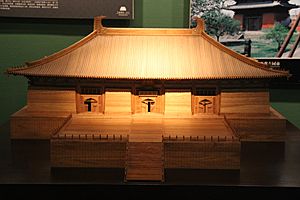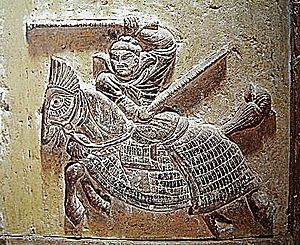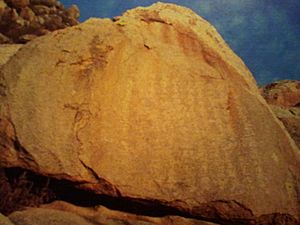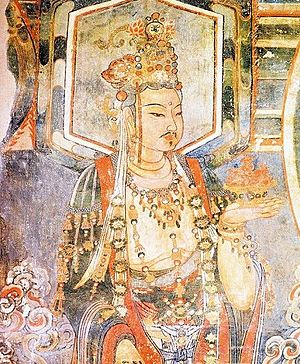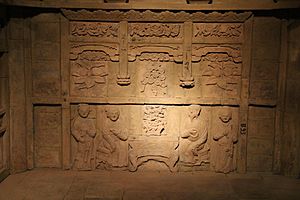Jin dynasty (1115–1234) facts for kids
Quick facts for kids
Great Jin
|
|||||||||||||||||||
|---|---|---|---|---|---|---|---|---|---|---|---|---|---|---|---|---|---|---|---|
| 1115–1234 | |||||||||||||||||||
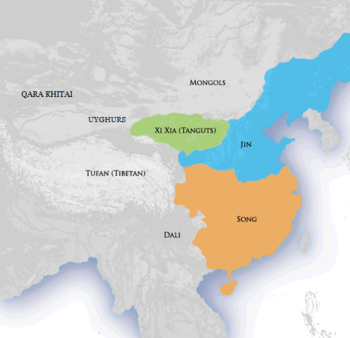
Location of Jin dynasty (blue), c. 1141
|
|||||||||||||||||||

Circuits of Jin
|
|||||||||||||||||||
| Capital |
|
||||||||||||||||||
| Common languages | Middle Chinese (later Old Mandarin), Jurchen, Khitan | ||||||||||||||||||
| Religion | |||||||||||||||||||
| Government | Monarchy | ||||||||||||||||||
| Emperor | |||||||||||||||||||
|
• 1115–1123
|
Taizu (first) | ||||||||||||||||||
|
• 1161–1189
|
Shizong | ||||||||||||||||||
|
• 1234
|
Modi (last) | ||||||||||||||||||
| Historical era | Medieval Asia | ||||||||||||||||||
|
• Founded by Aguda
|
28 January 1115 | ||||||||||||||||||
|
• Destruction of the Liao dynasty
|
1125 | ||||||||||||||||||
|
• Capture of Bianliang from the Northern Song dynasty
|
9 January 1127 | ||||||||||||||||||
|
• Mongol invasion
|
1211 | ||||||||||||||||||
|
• Fall of Caizhou to the Mongol Empire
|
9 February 1234 | ||||||||||||||||||
| Area | |||||||||||||||||||
| 1142 est. | 3,610,000 km2 (1,390,000 sq mi) | ||||||||||||||||||
| 1186 est. | 4,750,000 km2 (1,830,000 sq mi) | ||||||||||||||||||
| Population | |||||||||||||||||||
|
• 1186 est.
|
53,000,000 | ||||||||||||||||||
| Currency | Chinese coin, Chinese cash, and paper money See: Jin dynasty coinage (1115–1234) |
||||||||||||||||||
|
|||||||||||||||||||
| Today part of | |||||||||||||||||||
The Jin dynasty (/dʒɪn/; Chinese: 金朝; pinyin: Jīn Cháo), also called the Great Jin, was an important empire in Chinese history. It existed from 1115 to 1234. People sometimes call it the "Jurchen dynasty" because its rulers were from the Jurchen people.
The Jin dynasty started when Wanyan Aguda led a rebellion against the Liao dynasty. The Jin forces pushed the Liao people far away into Central Asia. After defeating the Liao, the Jin dynasty fought against the Northern Song dynasty for many years. The Jin emperors, who were Jurchen, slowly adopted Chinese customs. They even strengthened the Great Wall of China to protect against the rising Mongols. The Jin period also saw new cultural ideas, like a fresh interest in Confucianism.
After being powerful for centuries, the Jin dynasty faced the Mongols led by Genghis Khan in 1211. The Jin armies suffered huge defeats. After many losses and internal problems, the Jin dynasty finally fell to the Mongols in 1234.
Contents
What's in a Name?
The Jin dynasty was officially known as the "Great Jin." The Jin emperors also called their state "China" (Zhongguo). This shows that even non-Chinese rulers saw their empire as the true China. They believed "China" included all people, not just the Han Chinese.
A Look at Jin History
| Jin dynasty | |||||||||||||||||
|---|---|---|---|---|---|---|---|---|---|---|---|---|---|---|---|---|---|
| Chinese name | |||||||||||||||||
| Chinese | 金朝 | ||||||||||||||||
|
|||||||||||||||||
| Alternative Chinese name | |||||||||||||||||
| Chinese | 大金 | ||||||||||||||||
| Literal meaning | Great Jin | ||||||||||||||||
|
|||||||||||||||||
| Khitan name | |||||||||||||||||
| Khitan | Nik, Niku | ||||||||||||||||
Where the Jin Dynasty Began
The Jurchen people, who founded the Jin dynasty, likely came from the Mohe people. The Mohe lived in what is now Northeast China. They were mostly farmers and hunters. Horses were not common until later. The Mohe also practiced slavery.
The Jurchens first appeared in historical records in the 10th century. They sent gifts to the Liao, Later Tang, and Song courts. By the 10th century, the Jurchens were under the control of the Liao dynasty. However, they also traded with the Song dynasty.
In the 11th century, many Jurchens were unhappy with Liao rule. The Liao often took tribute (payments) from them by force. A Jurchen chief named Wugunai (1021–1074) became very powerful. He united many Jurchen tribes. His grandson, Aguda, would later start the Jin dynasty.
The Rise of Wanyan Aguda
The Jin dynasty was founded in 1115 by the Jurchen leader Aguda. He named his state "Jin," which means "gold." This name came from the "Anchuhu" River, which meant "golden" in the Jurchen language.
The Jurchens' early rulers were the Khitan-led Liao dynasty. The Liao controlled much of northern and northeastern China. In 1121, the Jurchens teamed up with the Northern Song dynasty to attack the Liao. The Jurchens succeeded in pushing the Liao into Central Asia.
After Aguda's death in 1125, the Jin dynasty broke its alliance with the Song. They invaded northern China. In 1127, the Jin army captured Kaifeng, the Song capital. They took both Emperor Qinzong and his father, Emperor Huizong, as prisoners.
The remaining Song leaders formed the Southern Song dynasty. They continued fighting the Jin for over ten years. In 1141, they signed the Treaty of Shaoxing. This treaty gave all Song lands north of the Huai River to the Jin. It also led to the execution of a Song general named Yue Fei.
Moving South and Changing Ways
After taking over northern China, the Jin dynasty started to adopt more Chinese ways. About three million people, including many Jurchens, moved south into northern China. This small group of Jurchens ruled over about 30 million people.
The Jurchens were given land and organized into military groups. Many Jurchens married Han Chinese people. Emperor Xizong (ruled 1135–1149) studied Chinese classics and wrote Chinese poetry. He adopted Chinese culture, but Jurchen nobles still held the most important positions.
Wanyan Liang became emperor in 1149. He moved the main capital from Huining Prefecture to Yanjing (modern Beijing) in 1153. He also rebuilt the old Song capital, Bianjing (modern Kaifeng), making it the Jin's southern capital.
Rebellions and Peace
Wanyan Liang wanted to rule all of China. He attacked the Southern Song dynasty in 1161. But two rebellions broke out in the north, one led by his cousin Wanyan Yong. Wanyan Liang had to pull his troops back from the south. His forces were defeated by the Song navy. He was killed by his own generals in December 1161.
Emperor Shizong (ruled 1161–1189) became the new emperor. He made peace with the Southern Song dynasty in 1164 with the Treaty of Longxing. This brought over 40 years of peace between the two empires.
Emperor Shizong helped the Jin Empire become rich and have plenty of grain. He also promoted Jurchen language and culture. His reign was known as a time of peace and success. His grandson, Emperor Zhangzong (ruled 1189–1208), also valued Jurchen traditions but loved Chinese culture too.
The Fall of the Jin Dynasty
In the early 1200s, the Jin dynasty faced a new threat: the Mongols from the north. Genghis Khan first attacked the Western Xia in 1205. In 1211, about 50,000 Mongol horsemen invaded the Jin Empire. The Jin had a large army, but they lost battles.
In 1213, the Mongols surrounded the Jin's "central capital," Zhongdu (modern Beijing). In 1214, the Jin made a difficult peace treaty. That summer, Emperor Xuanzong moved the government to Kaifeng, making it the new capital.
Many Chinese and Khitan people joined the Mongols to fight against the Jin dynasty. The Mongols even created a "Han Army" from Jin soldiers who switched sides.
Genghis Khan died in 1227. His successor, Ögedei Khan, invaded the Jin dynasty again in 1232. The Southern Song dynasty helped the Mongols. When the Mongols surrounded Kaifeng in 1233, Emperor Aizong fled south to Caizhou. The Jin dynasty finally fell in 1234. The Jin lands were divided between the Mongols and the Song. However, this led to new wars between the Song and the Mongols.
Jin Military Power
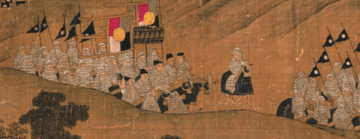
Chinese writers at the time said the Jurchens were successful because of their strong cavalry (soldiers on horseback). Jurchen horsemen wore heavy armor. Sometimes, they even used teams of horses chained together.
The Jin army also used many weapons from the Song military, like siege machines and artillery. In 1233, the Jin military used cannons, grenades, and rockets to defend Kaifeng against the Mongols. This is thought to be one of the first times gunpowder was used so effectively in battle.
However, the Jin military was not good at naval warfare. They were defeated by the Southern Song navies when trying to cross the Yangtze River in 1129–30 and 1161.
The Jin military was organized using a system called meng-an mou-k'o. This system was similar to the later Eight Banners of the Qing dynasty. It grouped all Jurchen families for both military and daily life. All men in a household had to serve in the military. Chinese and Khitan soldiers who joined the Jin were also part of this system.
The Jin Great Wall
To stop attacks from the Mongols, the Jin dynasty built a large section of the Great Wall of China. This Jin Great Wall was different from earlier ones. It was made by digging ditches and building walls inside them. Sometimes, extra walls and ditches were added for more strength.
Construction started around 1123 and finished by 1198. The two main parts built by the Jin dynasty are over 2,000 kilometers long.
How the Jin Government Worked
The Jin dynasty's government mixed Jurchen traditions with ideas from the Liao and Song dynasties. Before the dynasty, Jurchen tribes were ruled by tribal councils. There wasn't a strong central leader. These tribal customs stayed even after Aguda united the tribes.
The Jin dynasty had five capitals, a practice they learned from earlier empires. The early Jin government had to figure out how to rule an empire with many different ethnic groups. They did this by setting up separate government structures for different groups.
Jin Culture and Beliefs
The Jin dynasty had less contact with the Southern Song dynasty. Because of this, their cultures developed differently. For example, a new form of Confucianism that became popular in the Song dynasty did not take hold in the Jin. Jin scholars preferred the work of an earlier Song poet, Su Shi.
Buildings and Cities
The Jin dynasty brought back old city designs from the Tang dynasty. They built bell towers and drum towers in cities like Kaifeng and Zhongdu (Beijing). These towers would announce the night curfew. The Jurchens often lived in tents even within their Chinese-style cities.
Religion in the Jin Dynasty
Taoism
An important branch of Taoism called the Quanzhen School was founded during the Jin dynasty. It was started by a Chinese man named Wang Zhe (1113–1170). Many poems written during the Jin period were by Quanzhen Taoists.
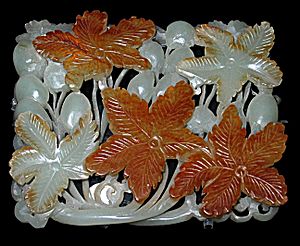
The Jin government also supported the creation of a large collection of Taoist writings. This collection, called the Precious Canon of the Mysterious Metropolis of the Great Jin, was finished in 1192. It contained 6,455 books! Sadly, not a single piece of it has survived today.
Buddhism
Buddhism also grew strong during the Jin dynasty. A large collection of Buddhist texts, called the Jin Tripitaka, was completed in 1173. It had about 7,000 books. This was a huge achievement in printing Buddhist texts.
Many Buddhist writings were also carved onto stone tablets. Members of the Jin imperial family and common people helped pay for these carvings. These stone carvings are very important for studying Chinese Buddhism today.
List of Emperors
| Temple name | Posthumous name1 | Jurchen name | Chinese name | Years of reign | Era name(s) and Years |
|---|---|---|---|---|---|
| Taizu (Chinese: 太祖) | Wuyuan (Chinese: 武元) | Aguda (Chinese: 阿骨打) | Min (Chinese: 旻) | 1115–1123 | Shouguo (Chinese: 收國; 1115–1116) Tianfu (Chinese: 天輔; 1117–1123) |
| Taizong (Chinese: 太宗) | Wenlie (Chinese: 文烈) | Wuqimai (Chinese: 吳乞買) | Sheng (Chinese: 晟) | 1123–1135 | Tianhui (Chinese: 天會; 1123–1135) |
| Xizong (Chinese: 熙宗) | Xiaocheng (Chinese: 孝成) | Hela (Chinese: 合剌) | Dan (Chinese: 亶) | 1135–1149 | Tianhui (Chinese: 天會; 1135–1138) Tianjuan (Chinese: 天眷; 1138–1141) Huangtong (Chinese: 皇統; 1141–1149) |
| None | – | Digunai (Chinese: 迪古乃) | Liang (Chinese: 亮) | 1149–1161 | Tiande (Chinese: 天德, 1149–1153) Zhenyuan (Chinese: 貞元; 1153–1156) Zhenglong (Chinese: 正隆; 1156–1161) |
| Shizong (Chinese: 世宗) | Renxiao (Chinese: 仁孝) | Wulu (Chinese: 烏祿) | Yong (Chinese: 雍) | 1161–1189 | Dading (Chinese: 大定; 1161–1189) |
| Zhangzong 章宗 |
Guangxiao (Chinese: 光孝) | Madage (Chinese: 麻達葛) | Jing (Chinese: 璟) | 1189–1208 | Mingchang (明昌; 1190–1196) Cheng'an (承安; 1196–1200) Taihe (泰和; 1200–1208) |
| None | – | Unknown | Yongji (Chinese: 永濟) | 1208–1213 | Da'an (Chinese: 大安; 1209–1212) Chongqing (Chinese: 崇慶; 1212–1213) Zhining (Chinese: 至寧; 1213) |
| Xuanzong 宣宗 |
Shengxiao (Chinese: 聖孝) | Wudubu (Chinese: 吾睹補) | Xun (Chinese: 珣) | 1213–1224 | Zhenyou (貞祐; 1213–1217) Xingding (興定; 1217–1222) Yuanguang (元光; 1222–1224) |
| Aizong (Chinese: 哀宗, official) Zhuangzong (Chinese: 莊宗, unofficial) Minzong (Chinese: 閔宗, unofficial) Yizong (Chinese: 義宗, unofficial) |
None | Ningjiasu (Chinese: 寧甲速) | Shouxu (Chinese: 守緒) | 1224–1234 | Zhengda (Chinese: 正大; 1224–1232) Kaixing (Chinese: 開興; 1232) Tianxing (Chinese: 天興; 1232–1234) |
| None | None | Hudun (Chinese: 呼敦) | Chenglin (Chinese: 承麟) | 1234 | Shengchang (Chinese: 盛昌; 1234) |
| 1: For full posthumous names, see the articles for individual emperors. | |||||
Emperors Family Tree
| Emperors family tree | |||||||||||||||||||||||||||||||||||||||||||||||||||||||||||||||||||||||||||||||||||||||||||||||||||||||||||||||||||||||||||||||||||||||||||||||||||||||||||||||||||||||||||||||||||||||||||||||||||||||||||||||||||||||||||||||||||||||||||||||||||||||||||||||||||||||||||||||||||||||||||||||||||||||||||||||||||||||||||||||||||||||||||||||||||||||||||||||||||||||||||||||||||||||||||||||||||||||||||||||||||||||||||||||||||||||||||||||||||||||||||||||||||||||||||||||||||||||||||||||||||||||||||||||||||||||||||||||||||||||||||||||||||||||||||||||||||||||||||||||||||||||||||||||||||||||||||||||||||||||||||||||||||||||||||||||||||||||||||||||||||||||||||||||||||||||||||||||||||||||||||||||||||||||||||||||||||||||||||||||||||||||||||||||||||||||||||||||||||||||||||||||||||||||||||||||||||||||||||||||||||||||||||||||||||||||||||||||||||||||||||||||||||||||||||||||||||||||||||||||||||||||||||||||||||||||||||||||||||||||||||||||||||||||||||||||||||||||||||||||||||||||||||||||||||||||||||||||||||||||
|---|---|---|---|---|---|---|---|---|---|---|---|---|---|---|---|---|---|---|---|---|---|---|---|---|---|---|---|---|---|---|---|---|---|---|---|---|---|---|---|---|---|---|---|---|---|---|---|---|---|---|---|---|---|---|---|---|---|---|---|---|---|---|---|---|---|---|---|---|---|---|---|---|---|---|---|---|---|---|---|---|---|---|---|---|---|---|---|---|---|---|---|---|---|---|---|---|---|---|---|---|---|---|---|---|---|---|---|---|---|---|---|---|---|---|---|---|---|---|---|---|---|---|---|---|---|---|---|---|---|---|---|---|---|---|---|---|---|---|---|---|---|---|---|---|---|---|---|---|---|---|---|---|---|---|---|---|---|---|---|---|---|---|---|---|---|---|---|---|---|---|---|---|---|---|---|---|---|---|---|---|---|---|---|---|---|---|---|---|---|---|---|---|---|---|---|---|---|---|---|---|---|---|---|---|---|---|---|---|---|---|---|---|---|---|---|---|---|---|---|---|---|---|---|---|---|---|---|---|---|---|---|---|---|---|---|---|---|---|---|---|---|---|---|---|---|---|---|---|---|---|---|---|---|---|---|---|---|---|---|---|---|---|---|---|---|---|---|---|---|---|---|---|---|---|---|---|---|---|---|---|---|---|---|---|---|---|---|---|---|---|---|---|---|---|---|---|---|---|---|---|---|---|---|---|---|---|---|---|---|---|---|---|---|---|---|---|---|---|---|---|---|---|---|---|---|---|---|---|---|---|---|---|---|---|---|---|---|---|---|---|---|---|---|---|---|---|---|---|---|---|---|---|---|---|---|---|---|---|---|---|---|---|---|---|---|---|---|---|---|---|---|---|---|---|---|---|---|---|---|---|---|---|---|---|---|---|---|---|---|---|---|---|---|---|---|---|---|---|---|---|---|---|---|---|---|---|---|---|---|---|---|---|---|---|---|---|---|---|---|---|---|---|---|---|---|---|---|---|---|---|---|---|---|---|---|---|---|---|---|---|---|---|---|---|---|---|---|---|---|---|---|---|---|---|---|---|---|---|---|---|---|---|---|---|---|---|---|---|---|---|---|---|---|---|---|---|---|---|---|---|---|---|---|---|---|---|---|---|---|---|---|---|---|---|---|---|---|---|---|---|---|---|---|---|---|---|---|---|---|---|---|---|---|---|---|---|---|---|---|---|---|---|---|---|---|---|---|---|---|---|---|---|---|---|---|---|---|---|---|---|---|---|---|---|---|---|---|---|---|---|---|---|---|---|---|---|---|---|---|---|---|---|---|---|---|---|---|---|---|---|---|---|---|---|---|---|---|---|---|---|---|---|---|---|---|---|---|---|---|---|---|---|---|---|---|---|---|---|---|---|---|---|---|---|---|---|---|---|---|---|---|---|---|---|---|---|---|---|---|---|---|---|---|---|---|---|---|---|---|---|---|---|---|---|---|---|---|---|---|---|---|---|---|---|---|---|---|---|---|---|---|---|---|---|---|---|---|---|---|---|---|---|---|---|---|---|---|---|---|---|---|---|---|---|---|---|---|---|---|---|---|---|---|---|---|---|---|---|---|---|---|---|---|---|---|---|---|---|---|---|---|---|---|---|---|---|---|---|---|---|---|---|---|---|---|---|---|---|---|---|---|---|---|---|---|---|---|---|---|---|---|---|---|---|---|---|---|---|---|---|---|---|---|---|---|---|---|---|---|---|---|---|---|---|---|---|---|---|---|---|---|---|---|---|---|---|---|---|---|---|---|---|---|---|---|---|---|---|---|---|---|---|---|---|---|---|---|---|---|---|---|---|---|---|---|---|---|---|---|---|---|---|---|---|---|---|---|---|---|---|---|---|---|---|---|---|---|---|---|---|---|---|---|---|---|---|---|---|---|---|---|---|---|---|---|---|---|---|---|---|---|---|---|---|---|---|---|---|---|---|---|---|---|---|---|---|---|---|---|---|---|---|---|---|---|---|---|---|---|---|---|---|---|---|---|---|---|---|---|---|---|---|---|---|---|---|---|---|---|---|---|---|---|---|---|---|---|---|---|---|---|---|---|---|---|---|---|---|---|---|---|---|---|---|---|---|---|---|---|---|---|---|---|---|---|---|---|---|---|---|---|---|---|---|---|---|---|---|---|---|---|---|---|---|---|---|---|---|---|---|---|---|---|---|---|---|---|---|---|---|---|---|---|---|---|---|---|---|---|---|---|---|---|---|---|---|---|---|---|---|---|---|---|---|---|---|---|---|---|---|---|---|---|---|---|---|---|---|---|
|
|||||||||||||||||||||||||||||||||||||||||||||||||||||||||||||||||||||||||||||||||||||||||||||||||||||||||||||||||||||||||||||||||||||||||||||||||||||||||||||||||||||||||||||||||||||||||||||||||||||||||||||||||||||||||||||||||||||||||||||||||||||||||||||||||||||||||||||||||||||||||||||||||||||||||||||||||||||||||||||||||||||||||||||||||||||||||||||||||||||||||||||||||||||||||||||||||||||||||||||||||||||||||||||||||||||||||||||||||||||||||||||||||||||||||||||||||||||||||||||||||||||||||||||||||||||||||||||||||||||||||||||||||||||||||||||||||||||||||||||||||||||||||||||||||||||||||||||||||||||||||||||||||||||||||||||||||||||||||||||||||||||||||||||||||||||||||||||||||||||||||||||||||||||||||||||||||||||||||||||||||||||||||||||||||||||||||||||||||||||||||||||||||||||||||||||||||||||||||||||||||||||||||||||||||||||||||||||||||||||||||||||||||||||||||||||||||||||||||||||||||||||||||||||||||||||||||||||||||||||||||||||||||||||||||||||||||||||||||||||||||||||||||||||||||||||||||||||||||||||||
See Also
 In Spanish: Dinastía Jin (1115-1234) para niños
In Spanish: Dinastía Jin (1115-1234) para niños
- Eastern Xia
- Jurchen Jin emperors family tree
- Korean–Jurchen border conflicts
- Timeline of the Jin–Song Wars



